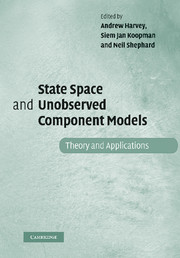Book contents
- Frontmatter
- Contents
- Preface
- Acknowledgements
- Part I State space models
- Part II Testing
- Part III Bayesian inference and bootstrap
- Part IV Applications
- 10 Measuring and forecasting financial variability using realised variance
- 11 Practical filtering for stochastic volatility models
- 12 On RegComponent time series models and their applications
- 13 State space modelling in macroeconomics and finance using SsfPackin S+Finmetrics
- 14 Finding genes in the human genome with hidden Markov models
- References
- Author index
- Subject index
14 - Finding genes in the human genome with hidden Markov models
Published online by Cambridge University Press: 06 January 2010
- Frontmatter
- Contents
- Preface
- Acknowledgements
- Part I State space models
- Part II Testing
- Part III Bayesian inference and bootstrap
- Part IV Applications
- 10 Measuring and forecasting financial variability using realised variance
- 11 Practical filtering for stochastic volatility models
- 12 On RegComponent time series models and their applications
- 13 State space modelling in macroeconomics and finance using SsfPackin S+Finmetrics
- 14 Finding genes in the human genome with hidden Markov models
- References
- Author index
- Subject index
Summary
Abstract
Large scale genome sequencing generates very long sequences of DNA bases, which we can view as sequences over a four letter alphabet. An important analysis goal is to identify the genes or subsequences that code for proteins. We can view this as a statistical inference problem, where we have a model for gene structure and the sequence properties of gene-encoding regions, and many examples of known genes. Here I review the approach taken in most recent gene finding methods, based on hidden Markov models, which are a type of discrete state space model. I also discuss ways that further information can be incorporated, including a comparative sequence from a related organism, such as mouse for human sequence analysis.
Introduction and background
I would like to preface this short review by saying what a pleasure it is to be able to contribute to this collection of papers associated with the work of my father, Jim Durbin. Although on the surface I have followed a very different career path than my father, working on computational and mathematical issues connected to molecular biology and genetics, there are some surprising parallels between the methods we have been using in the last few years. Just as the formalism of state space models has proved powerful and flexible for encompassing and generalising a variety of older approaches to time series analysis, a discrete space, discrete observation version of the state space model, the hidden Markov model (HMM), has come to play a significant role in unifying earlier approaches to biological sequence analysis and stimulating new developments, see Durbin, Eddy, Krogh and Mitchison (1998).
- Type
- Chapter
- Information
- State Space and Unobserved Component ModelsTheory and Applications, pp. 336 - 350Publisher: Cambridge University PressPrint publication year: 2004



